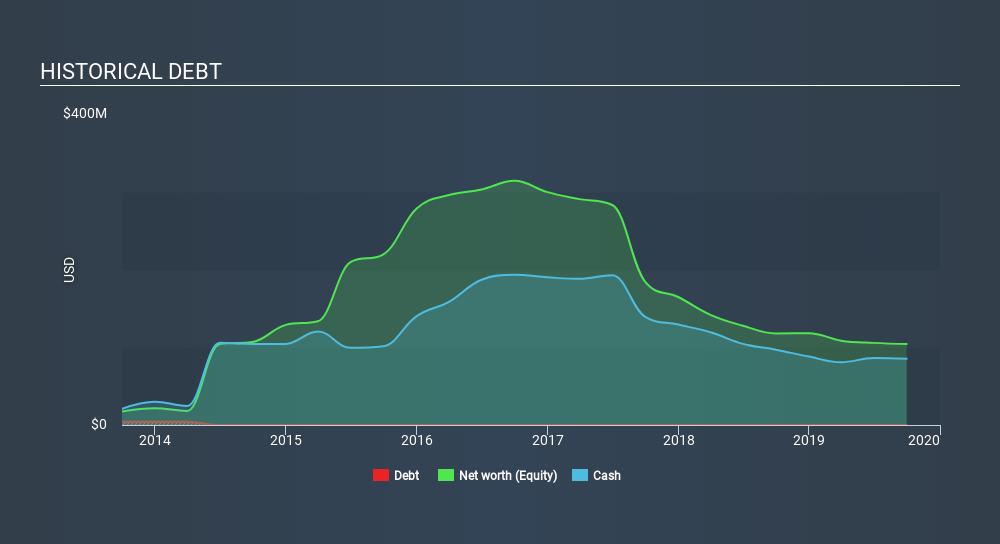- United States
- /
- Media
- /
- NasdaqGS:MGNI
Here's Why We're Not At All Concerned With Rubicon Project's (NYSE:RUBI) Cash Burn Situation

We can readily understand why investors are attracted to unprofitable companies. By way of example, Rubicon Project (NYSE:RUBI) has seen its share price rise 123% over the last year, delighting many shareholders. But while history lauds those rare successes, those that fail are often forgotten; who remembers Pets.com?
In light of its strong share price run, we think now is a good time to investigate how risky Rubicon Project's cash burn is. In this report, we will consider the company's annual negative free cash flow, henceforth referring to it as the 'cash burn'. First, we'll determine its cash runway by comparing its cash burn with its cash reserves.
View our latest analysis for Rubicon Project
When Might Rubicon Project Run Out Of Money?
A company's cash runway is the amount of time it would take to burn through its cash reserves at its current cash burn rate. In September 2019, Rubicon Project had US$85m in cash, and was debt-free. Importantly, its cash burn was US$9.8m over the trailing twelve months. So it had a cash runway of about 8.7 years from September 2019. Importantly, though, analysts think that Rubicon Project will reach cashflow breakeven before then. In that case, it may never reach the end of its cash runway. Depicted below, you can see how its cash holdings have changed over time.

How Well Is Rubicon Project Growing?
Happily, Rubicon Project is travelling in the right direction when it comes to its cash burn, which is down 77% over the last year. And revenue is up 30% in that same period; also a good sign. It seems to be growing nicely. Clearly, however, the crucial factor is whether the company will grow its business going forward. For that reason, it makes a lot of sense to take a look at our analyst forecasts for the company.
How Hard Would It Be For Rubicon Project To Raise More Cash For Growth?
There's no doubt Rubicon Project seems to be in a fairly good position, when it comes to managing its cash burn, but even if it's only hypothetical, it's always worth asking how easily it could raise more money to fund growth. Issuing new shares, or taking on debt, are the most common ways for a listed company to raise more money for its business. Commonly, a business will sell new shares in itself to raise cash to drive growth. By comparing a company's annual cash burn to its total market capitalisation, we can estimate roughly how many shares it would have to issue in order to run the company for another year (at the same burn rate).
Rubicon Project has a market capitalisation of US$577m and burnt through US$9.8m last year, which is 1.7% of the company's market value. That means it could easily issue a few shares to fund more growth, and might well be in a position to borrow cheaply.
So, Should We Worry About Rubicon Project's Cash Burn?
As you can probably tell by now, we're not too worried about Rubicon Project's cash burn. For example, we think its cash runway suggests that the company is on a good path. But it's fair to say that its revenue growth was also very reassuring. It's clearly very positive to see that analysts are forecasting the company will break even fairly soon. Taking all the factors in this report into account, we're not at all worried about its cash burn, as the business appears well capitalized to spend as needs be. While it's important to consider hard data like the metrics discussed above, many investors would also be interested to note that Rubicon Project insiders have been trading shares in the company. Click here to find out if they have been buying or selling.
Of course, you might find a fantastic investment by looking elsewhere. So take a peek at this free list of companies insiders are buying, and this list of stocks growth stocks (according to analyst forecasts)
If you spot an error that warrants correction, please contact the editor at editorial-team@simplywallst.com. This article by Simply Wall St is general in nature. It does not constitute a recommendation to buy or sell any stock, and does not take account of your objectives, or your financial situation. Simply Wall St has no position in the stocks mentioned.
We aim to bring you long-term focused research analysis driven by fundamental data. Note that our analysis may not factor in the latest price-sensitive company announcements or qualitative material. Thank you for reading.
About NasdaqGS:MGNI
Magnite
Operates an independent omni-channel sell-side advertising platform in the United States and internationally.
Moderate growth potential with acceptable track record.
Similar Companies
Market Insights
Community Narratives


